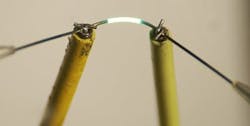Darmstadt, Germany--Scientists at the Technische Universität Darmstadt (TU Darmstadt) are vacuum-depositing organic semiconductors onto fibers, creating devices such as organic LED (OLED) fibers that emit light. The technology is aimed at "smart textiles," or electronically and photonically active clothing and other cloth.
“In theory, reproducible rotational coating with semiconductor components opens up a whole new world of possibilities in smart textiles,” says Heinz von Seggern, director of the field of Electronic Material Properties at the TU Darmstadt.
Tobias Könyves-Toth, a materials scientist at TU Darmstadt, who developed the technique as part of the LUMOLED joint project of the Federal Ministry for Education and Research (BMBF), has been able to vacuum-deposit organic-semiconductors onto glass fibers, and is aiming next to coat polymer-coated fibers. “We turned to OLEDs because they require the highest standards concerning the substrates," he says. "Today, we are able to apply functioning OLEDs to a thread and make it glow. Applying other devices such as transistors or solar-cell photovoltaics includes other problems, but is comparatively less complex when it comes to the actual coating.”
The components are applied to a thread by heating the materials in vacuum until they sublime; the materials then condense on the fiber. A total of seven layers have to be applied to the fiber, some of them just 200 nm thick. This is where another problem arises: textile fibers have a rough surface, but the electronic components only work on a smooth surface; even scratches just a few nanometers thick can cause short-circuiting and other problems.
Still lacking durability
“That is why we tried to use glass fibers for our first trials, because they have a very smooth surface,” says Könyves-Toth. But glass fibers are not suitable for textiles—therefore the experimentation with polymer-coated glass fibers. The aim is to use the polymer coating to smooth the fiber surface for a subsequent coating with organic semiconductor elements while providing flexibility to be woven in textiles.
Although the trials have been a success, there is still some way to go before smart textiles based on this technology are a reality. The lifetime of the electric functionality is limited, as there is as yet no solution for a protective layer to protect the organic semiconductor molecules against oxygen and moisture.
Although first attempts have been made, it is going to take some time before the process is ready for the market. The fibers that have been used so far are still too brittle and too thick (0.5 mm thick) to be woven into textiles; nor are the fibers able to cope with the mechanical loads that occur during the weaving process and when garments are worn.
The researchers are now looking into patenting their work.
Source: http://www.tu-darmstadt.de/vorbeischauen/aktuell/news_details_76160.en.jsp
About the Author
John Wallace
Senior Technical Editor (1998-2022)
John Wallace was with Laser Focus World for nearly 25 years, retiring in late June 2022. He obtained a bachelor's degree in mechanical engineering and physics at Rutgers University and a master's in optical engineering at the University of Rochester. Before becoming an editor, John worked as an engineer at RCA, Exxon, Eastman Kodak, and GCA Corporation.

